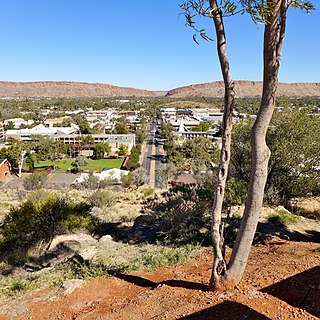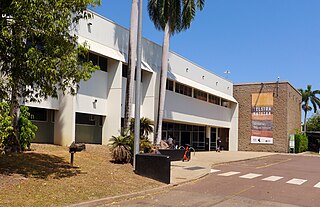Related Research Articles

Alice Springs is a town in the Northern Territory, Australia; the third largest settlement after Darwin and Palmerston. The name Alice Springs was given by surveyor William Whitfield Mills after Alice, Lady Todd, wife of the telegraph pioneer Sir Charles Todd. Known colloquially as "The Alice" or simply "Alice", the town is situated roughly in Australia's geographic centre. It is nearly equidistant from Adelaide and Darwin.

The Araluen Cultural Precinct, formerly the Araluen Centre for Arts & Entertainment, in Alice Springs in the Northern Territory of Australia, is a cultural precinct which includes the Araluen Arts Centre, the Museum of Central Australia, Central Australian Aviation Museum, Kookaburra Memorial, Yeperenye Sculpture, Central Craft, a cafe, and Aboriginal sacred sites.

Emily Kame Kngwarreye was an Aboriginal Australian artist from the Utopia community in the Northern Territory. She is one of the most prominent and successful artists in the history of Australian art.

Utopia, also known as Urapuntja and Amengernterneah, is an Aboriginal Australian homeland area formed in November 1978 by the amalgamation of the former Utopia pastoral lease, from which it gains its name, with a tract of unalienable land to its north. It covers an area of 3,500 km2 (1,400 sq mi), transected by the Sandover River, and lies on a traditional boundary of the Alyawarre and Anmatyerre people, the two Aboriginal language groups which predominate there today.
The Tandanya National Aboriginal Cultural Institute, usually referred to as Tandanya, is an art museum located on Grenfell Street in Adelaide, South Australia. It specialises in promoting Indigenous Australian art, including visual art, music and storytelling. It is the oldest Aboriginal-owned and -run cultural centre in Australia.

The Museum and Art Gallery of the Northern Territory (MAGNT) is the main museum in the Northern Territory. The museum is located in the inner Darwin suburb of Fannie Bay. The MAGNT is governed by the Board of the Museum and Art Gallery of the Northern Territory and is supported by the Museums and Art Galleries of the Northern Territory Foundation. Each year the MAGNT presents both internally developed exhibitions and travelling exhibitions from around Australia. It is also the home of the annual Telstra National Aboriginal and Torres Strait Islander Art Award, Australia's longest-running set of awards for Indigenous Australian artists.
Daisy Jugadai Napaltjarri was a Pintupi-Luritja-speaking Indigenous artist from Australia's Western Desert region, and sister of artist Molly Jugadai Napaltjarri. Daisy Jugadai lived and painted at Haasts Bluff, Northern Territory. There she played a significant role in the establishment of Ikuntji Women's Centre, where many artists of the region have worked.
Tjunkiya Napaltjarri was a Pintupi-speaking Indigenous artist from Australia's Western Desert region. She is the sister of artist Wintjiya Napaltjarri.
Lucy Napaljarri Kennedy is a Walpiri and Anmatyerre-speaking Indigenous artist from Australia's Western Desert region. One of the first Indigenous women artists to paint in acrylics, her work has been exhibited at major galleries around Australia, and is held in the collection of the National Gallery of Victoria. She was made a Member of the Order of Australia in 1994 for services to the Yuendumu community.
Sheila Brown Napaljarri was a Warlpiri-speaking Indigenous artist from Australia's Western Desert region. A contributor to major collaborative paintings by Indigenous communities, her works are also held by the Art Gallery of New South Wales and the South Australian Museum.
Contemporary Indigenous Australian art is the modern art work produced by Indigenous Australians, that is, Aboriginal Australians and Torres Strait Islander people. It is generally regarded as beginning in 1971 with a painting movement that started at Papunya, northwest of Alice Springs, Northern Territory, involving Aboriginal artists such as Clifford Possum Tjapaltjarri and Kaapa Tjampitjinpa, and facilitated by white Australian teacher and art worker Geoffrey Bardon. The movement spawned widespread interest across rural and remote Aboriginal Australia in creating art, while contemporary Indigenous art of a different nature also emerged in urban centres; together they have become central to Australian art. Indigenous art centres have fostered the emergence of the contemporary art movement, and as of 2010 were estimated to represent over 5000 artists, mostly in Australia's north and west.
Hetti Kemerre Perkins is an Aboriginal Australian art curator and writer. She is known for her work at the Art Gallery of New South Wales, where she was the senior curator of Aboriginal and Torres Strait Islander art at the gallery from around 1998 until 2011, and for many significant exhibitions and projects.
Kunmanara Tjilpi Kankapankatja, Robin Kankapankatja, was an Australian Aboriginal artist. He worked for most of his life as a labourer and conservationist. He is the manager and senior traditional owner of Walalkara, a homeland and Indigenous protected area on the Aṉangu Pitjantjatjara Yankunytjatjara Lands. He began work as an artist in 2004, aged in his 70s. His artworks are now held in several major galleries in Australia.
Kudditji Kngwarreye was an Australian Aboriginal artist from the Utopia community in the Northern Territory. He was the brother of the late Emily Kame Kngwarreye. Like his skin sister Emily, he was one of the most prominent and successful artists in the history of contemporary indigenous Australian art.
Tarnanthi is a Festival of Contemporary Aboriginal and Torres Strait Islander Art held in Adelaide, South Australia, annually. Presented by the Art Gallery of South Australia (AGSA) in association with the South Australian Government and BHP. It is curated by Nici Cumpston.
Pamela Lofts, also known as Pam Lofts, was an Australian children's book illustrator and exhibiting artist based in Alice Springs in the Northern Territory of Australia. She is best remembered as the illustrator of the Australian classic children's books, Wombat Stew by Marcia Vaughan and Koala Lou by Mem Fox. Although known for her book illustrations, she was also a photographer, painter, and sculptor.
Marina Strocchi is an internationally-exhibited Australian painter and printmaker whose work is held in many national collections. Strocchi is based in Alice Springs and has worked extensively with Aboriginal artists in Central Australia.
Pantjiti Mary McLean was an Australian Ngaatjajarra Aboriginal artist.
Long Jack Phillipus Tjakamarra, occasionaly referred to as Kumantjayi Long Tjakamarra, was a Ngalia/Warlpiri man and a founding member of the Papunya Tula art cooperative. His contribution to the Honey Ant Dreaming mural would help define and catalyze the art style of the Western Desert Art Movement.
References
- ↑ "Desert Mob 30". Araluen Arts centre. Archived from the original on 10 September 2021. Retrieved 9 September 2021.
- ↑ "Desert Mob turns 30". Art Collector Magazine. 29 July 2020. Retrieved 9 September 2021.
- ↑ "30 years of Desert Mob". ArtsHub Australia. 17 August 2020. Retrieved 10 September 2021.